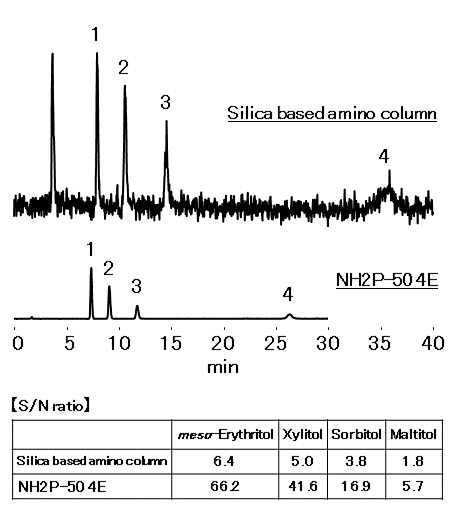The evaporative light scattering detector (ELSD) is a detector that measures the scattering of light of particles. This is achieved by evaporating the eluent eluted from the column, converting the eluate into particles and irradiating the particles with laser. Samples of interest include sugars and lipids and are used for applications similar to with a differential refractive index detectors (RID), but with ELSD a gradient elution analysis is possible and it is more sensitive. On the other hand, if there is a lot of bleed from the column, background noise increases and there is a possibility that sensitivity drops. Here, we compare the detection sensitivity of sugar alcohols by ELSD using polymer-based amino column Asahipak NH2P-50 4E and silica-based amino column. Compared with silica-based amino column, NH2P-50 4E has less column bleed, and it shows that the detection sensitivity is high with a larger signal-to-noise (S/N) ratio for all sugar alcohol peaks.
Sample: 20 μL
40 µg/mL each (in 50 % CH3CN)
- 1.meso-Erythritol
- 2.Xylitol
- 3.Sorbitol
- 4.Maltitol

- (Note)
- Since ELSD's signal response has an exponential function instead of linear function, bleed noise amplifies each signal's peak exponentially which results in higher peak heights for the eluates for the silica-based columns. However, the signal-to-noise ratio is low in this case compared to the polymer-based columns where bleed noise is less.
- Column
- :Shodex Asahipak NH2P-50 4E, Silica based amino column (4.6 mm I.D. x 250 mm each)
- Eluent
- :CH3CN/H2O=80/20
- Flow rate
- :1.0 mL/min
- Detector
- :ELSD
- Column temp.
- :30 ℃
Sample Name Index
Operation Manual / Certificate of Analysis
Operation Manuals and Certificate of Analysis / Inspection Certificate for the following products can be downloaded here.
Product Name Index
Applications
- Elution Volume of Saccharides and Sugar Alcohols (NH2P-50 4E)
- Sugar Alcohols (1) (SC1211)
- Sugar Alcohols (2) (NH2P-50)
- Sugar Alcohols (3)
- Saccharides and Sugar Alcohols (1) (SZ5532)
- Saccharides and Sugar Alcohols (2) (SP0810)
- Saccharides and Sugar Alcohols (3) (SP0810)
- Saccharides and Sugar Alcohols (4) (SC1011)
- Saccharides and Sugar Alcohols (5) (SZ5532)
- Saccharides and Sugar Alcohols (6) (NH2P-50)
- Saccharides and Amino Acids (1) (SC1011)
- Saccharides and Amino Acids (2) (SC1211)
- Saccharides and Amino Acids (3) (KS-801)
- Saccharides and Amino Sugars (2) (NH2P-50 4E)
- Saccharides and Amino Sugars (3) (SC1011)
- Xilitol in Tablet Candy
- Apple Juice (NH2P-50 4E)
- Apple Juice (SC1011)
- Sake (Japanese Rice Wine)
- Effects of Acetonitrile Concentration in Analysis of Sugar Alcohols
- Amino Sugars (SB-802.5 HQ)
- Soft Drink Containing Erythritol (NH2P-50 4E)
- Palatinit (SP0810, SC1011, SZ5532)
- Analysis of Pinitol (SP0810)
- Analysis of Meglumine (NN-814)
- LC/MS/MS Analysis of Meglumine (VC-50 2D)
- Analysis of Meglumine (YS-50)
- Separation of myo-Inositol and D-chiro-Inositol (SZ5532)
- Separation of Taurine and Inositol (NH2P-50 4E)
- Analysis of Hydrogenated Maltose Starch Syrup According to Japanese Pharmaceutical Excipients Method (KS-801)
- Analysis of Mannitol According to Pharmacopeia Method (SC1011-7F)
- Analysis of myo-Inositol According to EP Method (SC1011-7F)
- Analysis of Xylitol According to USP-NF Method (SP0810)
- Analysis of Sorbitol According to USP-NF Method (SP0810 8C)
- Analysis of Maltitol According to USP-NF Method (SP0810 8C)
- Analysis of Erythrose and Erythritol (VG-50 4E)
